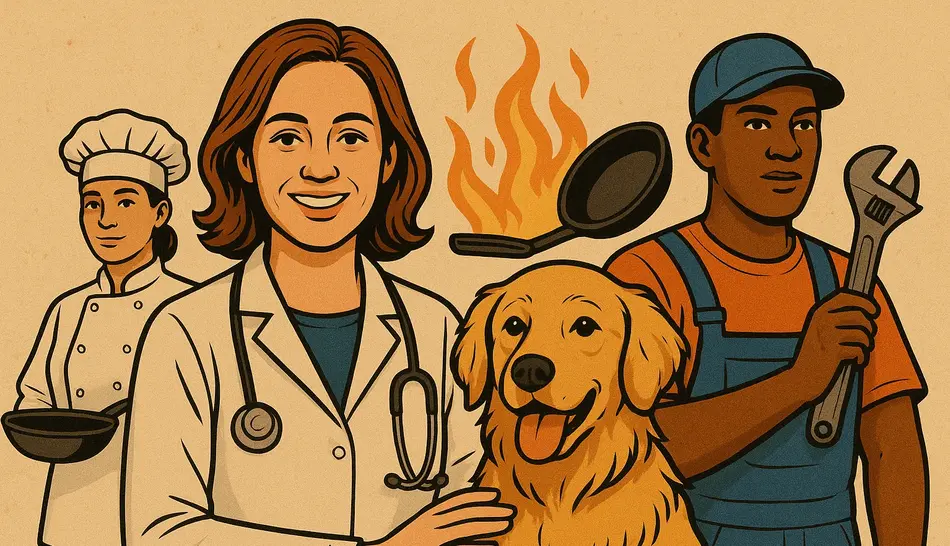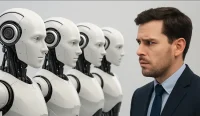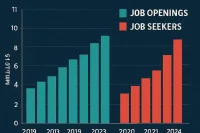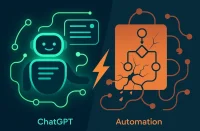Jobs AI will never replace — the study that reveals AI-proof careers
Jobs AI will never replace represent a growing category of careers that remain protected from automation despite AI’s rapid advancement. While artificial intelligence is devastating white-collar careers—with Pew Research Center showing that workers with higher educational degrees are most likely to be replaced—certain professions appear to be AI-proof. For the first time ever, white-collar jobs in California are shrinking while blue-collar jobs are growing, leading young people to prefer trade careers over university degrees.
The AI displacement reality
White-collar jobs most at risk
AI is having a devastating impact on white-collar careers, with the highest-paying jobs being the ones most at risk of disappearing. According to Goldman Sachs, AI could automate up to 18% of global work, with particularly strong impact on administrative, office, and support jobs. The World Economic Forum warns that around 83 million jobs could disappear by 2027 due to automation.
College graduates face accelerating unemployment
The unemployment rate is accelerating much faster for fresh college graduates, with 60% of all US workers concerned about AI’s impact on their jobs over the next 10 years. This represents a fundamental shift in the job market that’s forcing young people to reconsider traditional career paths.
Most vulnerable professions to AI replacement
Administrative and office support roles
Administrative sectors face the highest risk, with data entry, spreadsheet management, and low-level accounting functions at risk of disappearing at rates ranging from 40% to 70%. The Bureau of Labor Statistics reports that data entry clerk occupations have declined by more than 25% in the past decade, with accelerated decline expected by 2030.
Customer service transformation
Customer service is undergoing massive transformation, with Gartner estimating that 75% of customer service interactions will be managed by AI by 2026, compared to 20% in 2019. This represents a significant reduction in demand for call center agents, a job that currently employs more than 17 million people worldwide.
Content creation and translation
Translation and basic content writing face substantial disruption. Google Translate has surpassed 90% accuracy, while AI tools like ChatGPT allow companies to produce articles, reports, and technical manuals in minutes. Around 45% of translator tasks could be taken over by AI in the next 10 years, with 37% of US companies already using generative AI for writing tasks.
Jobs AI will never replace — the protected professions
Healthcare professionals remain irreplaceable
Doctors, nurses, and mental health professionals remain relatively protected from AI replacement. According to Goldman Sachs, less than 5% of tasks performed by mental health professionals can currently be automated. Healthcare providers require empathy, moral judgment, and complex decision-making that AI cannot replicate.
Education and human interaction
Teachers and educators face minimal automation risk, with less than 10% of their tasks automatable. Personal interaction and pedagogical adaptation remain irreplaceable, making education one of the most AI-resistant professions.
Skilled trades and manual work
Electricians, plumbers, and maintenance technicians present lower automation risks because physical tasks in non-standardized environments face technical limitations and high costs. The US Department of Labor projects 6% growth for electrical installation and repair technicians between 2022 and 2032.
Why certain jobs remain AI-proof
Human skills that cannot be replicated
Jobs requiring high levels of empathy, moral judgment, creativity, and complex problem-solving remain protected. These human skills are difficult to automate and often require contextual understanding that AI cannot achieve.
Physical and environmental challenges
Manual trades require physical dexterity and adaptation to changing environments that robotics cannot yet replicate efficiently. The growing shortage of plumbers and electricians demonstrates the continued demand for these AI-resistant skills.
Personal interaction requirements
Professions requiring face-to-face interaction, emotional intelligence, and personalized service remain largely protected from automation, as these human qualities cannot be easily replicated by machines.
Hire AI-Proof Talent That Lasts
Empathy, judgment, creativity, and hands-on skillsets remain beyond automation. From plumbers and electricians to healthcare professionals and service leaders, these roles are the foundation of an AI-augmented economy. Post your job on WhatJobs today and connect with resilient talent that brings the human edge machines can’t replicate.
Post a Job Free for 30 Days →The blue-collar job renaissance
Young people choosing trades over college
More young people are now opting for blue-collar jobs over college degrees, recognizing that these careers offer stability and protection from AI displacement. This represents a significant cultural shift in career preferences.
Growing demand for skilled trades
There’s a growing shortage of skilled tradespeople across the country, creating opportunities for those willing to pursue these AI-resistant careers. These jobs often offer competitive wages and job security that white-collar positions can no longer guarantee.
AI as a complement, not replacement
Healthcare AI enhancement
In healthcare, AI isn’t replacing doctors but enabling them to provide better patient care. From assisted diagnostic systems to predictive analysis platforms, AI tools enhance rather than replace human medical professionals.
Automated communication systems
Healthcare systems are using AI to automate communication between providers and patients, improving efficiency while maintaining the human touch in medical care. This represents the ideal model of human-AI collaboration.
Reskilling and adaptation requirements
Digital skills transformation
According to IBM, 40% of the global workforce will need to reskill in new digital skills over the next 3 years, equivalent to more than 1.4 billion workers. Even protected occupations will require greater familiarity with AI tools.
Training and education gaps
The International Labor Organization estimates that 60% of workers worldwide lack access to adequate professional retraining programs, increasing the risk of widening labor and social inequality.
Economic and social implications
Wage and education paradox
The paradox of AI displacement is that the highest-paying jobs are most at risk, while lower-paying but AI-resistant jobs are growing. This creates complex economic dynamics that challenge traditional assumptions about education and career advancement.
Regional impact variations
In regions like Latin America, where customer service expanded over the past two decades, AI could represent the loss of up to 2 million jobs in the next 5 years. The impact varies significantly by geographic location and economic structure.
Policy and preparation strategies
Government intervention needs
Governments must anticipate this transition through training, reskilling, and social protection policies. The challenge is to ensure that technological progress doesn’t leave entire populations behind.
Corporate responsibility
Companies must balance efficiency gains from AI with responsibility to their workforce, investing in retraining programs and supporting employees through technological transitions.
Future outlook and predictions
Continued AI advancement
As AI technology continues advancing rapidly, the line between replaceable and irreplaceable jobs may shift. However, human-centered skills like empathy, creativity, and complex problem-solving are likely to remain valuable.
Hybrid work models
The future may see more hybrid models where AI handles routine tasks while humans focus on complex decision-making, creative problem-solving, and interpersonal interaction.
FAQs
Q: What are the jobs AI will never replace?
A: Healthcare professionals (doctors, nurses, mental health workers), teachers, skilled trades (plumbers, electricians), and roles requiring empathy, creativity, and complex human interaction.
Q: Why are jobs AI will never replace protected from automation?
A: These jobs require human skills like empathy, moral judgment, creativity, physical dexterity, and complex problem-solving that AI cannot replicate effectively.
Q: How many jobs are at risk from AI according to studies on jobs AI will never replace?
A: Goldman Sachs estimates AI could automate 18% of global work, while the World Economic Forum warns 83 million jobs could disappear by 2027 due to automation.
Q: What should workers do if their jobs aren’t among jobs AI will never replace?
A: Focus on developing human-centered skills, consider transitioning to AI-resistant careers, and invest in continuous learning to work alongside AI rather than compete with it.
Live example — user point of view
As a former marketing manager who lost my job to AI automation, I decided to retrain as an electrician. While my white-collar peers are still struggling with job insecurity, I’m now in high demand with steady work and good pay. The irony is that my college degree didn’t protect me from AI, but my hands-on skills and ability to solve complex problems in unpredictable environments have made me AI-proof. Young people are starting to realize that sometimes the most secure career path is the one that requires skills AI simply cannot replicate.




